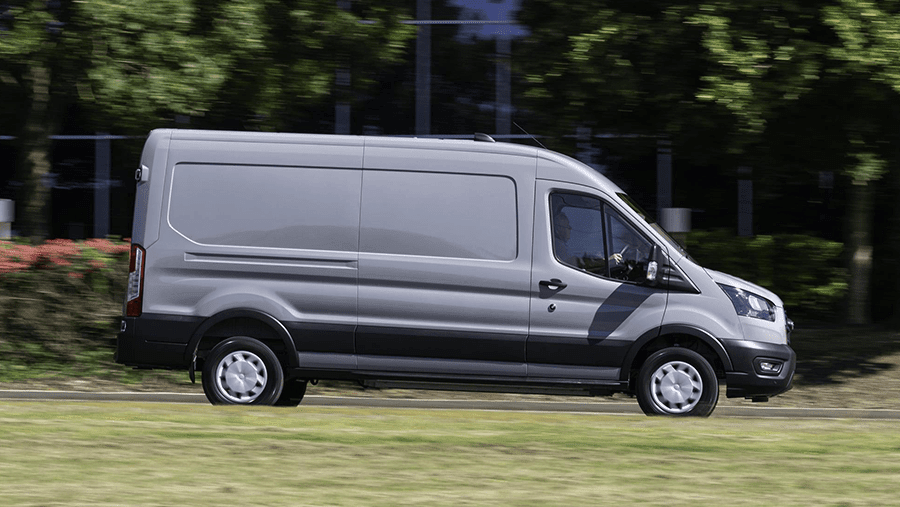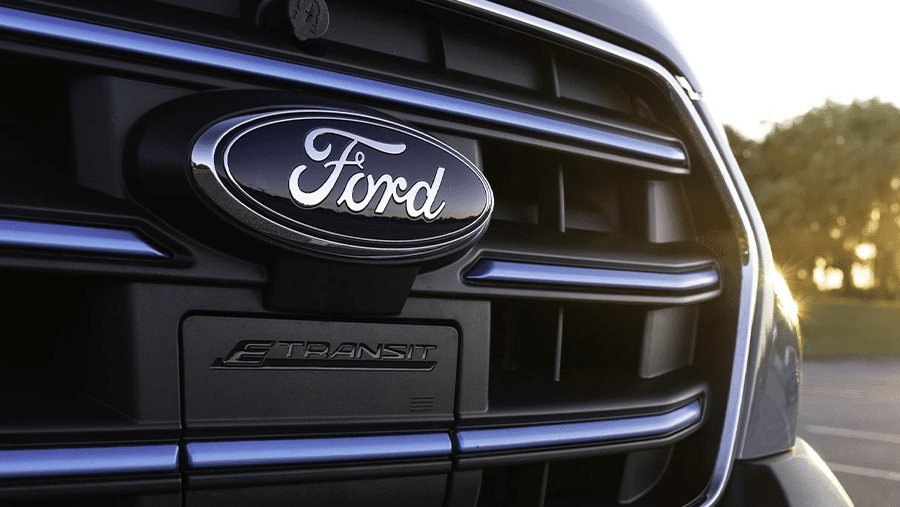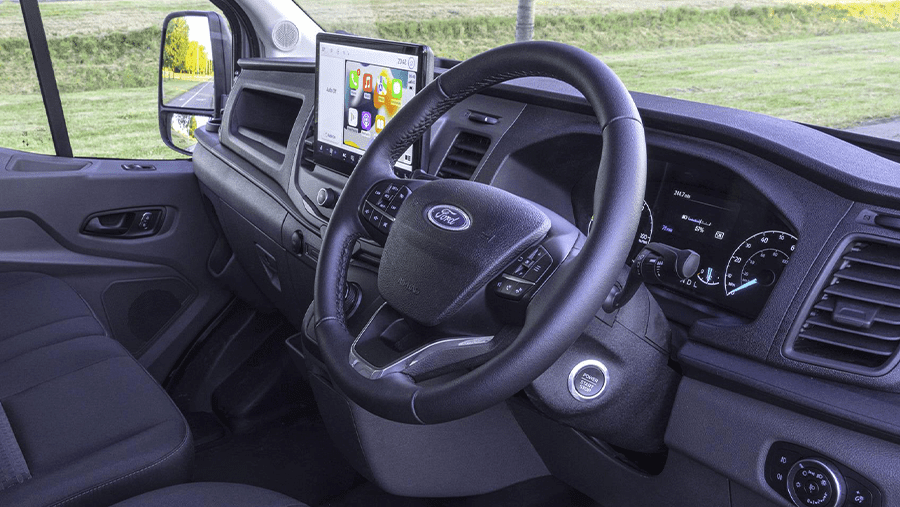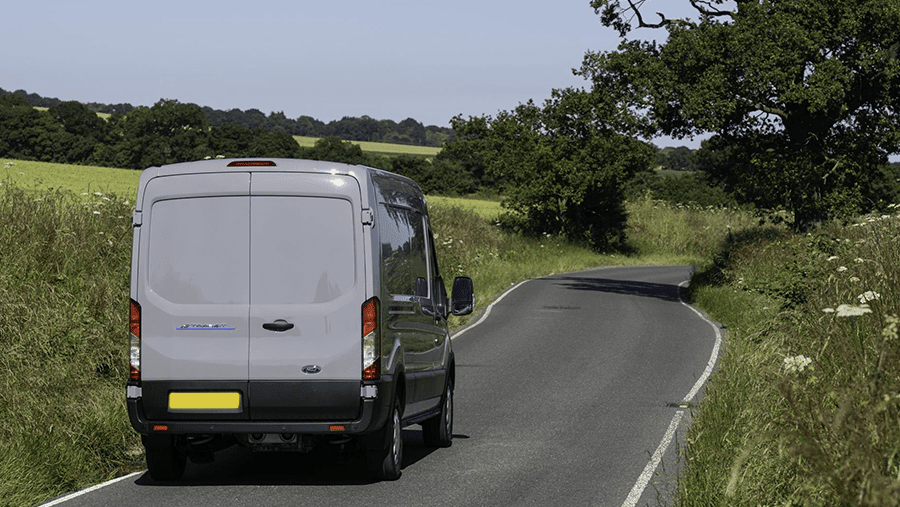
Ford E-Transit Van Review

Introduction
If there’s a more important vehicle for Ford to electrify than the Transit, we don’t know what it is. The biggest selling van in the UK for, well, possibly ever needs to make a significant impact if the prospect of switching to electric power is going to take off before any enforced diesel ban.
Ford has played it safe with its first foray into the e-LCV world, leaving the E-Transit looking every bit as conventional as its diesel-powered sibling, but there’s a lot more going on under the skin.
We take the wheel and head out onto the nation's roads to see if this, the electric version of the ‘backbone of Britain’ is a viable alternative to the UK’s most popular model.
Select's rating score* - 4.8 / 5
At a Glance
It’s been several years since the current-generation Transit entered service, and converting an existing model to electric power often leaves the finished product compromised - just look at the efforts from Citroen and Peugeot.

Ford has invested heavily in the E-Transit, though, to the degree that it feels like the van was designed to accommodate an electric powertrain right from the drawing board.
What we’re saying is that this is no after-market conversion by a third party but a proper OEM effort with the design, build quality and backup that you would expect.
The word ‘uncompromised’ gets thrown around with abandon, but it’s almost true here.
Key Features
Ford’s honesty in the E-Transit’s capabilities is to be admired. While the headline figure of 196 miles from a fully charged battery pack is commendable, we all appreciate that real-life use throws a proverbial spanner in the works.

However, Ford promises that the E-Transit has a ‘dependable’ range of 100 miles. That might sound too compromised for many, but that figure is what Ford feels is achievable when the van is fully-loaded, on a motorway, in the freezing cold. It even factors an ageing battery into that figure, meaning you’ll have that surety even after years of hard work.
The thousands of vehicles that Ford tracks using its Ford Pro Liive (yes, with a double-i) service show that the average Transit covers just 59.5 miles a day, so while some users will find the limitations too much to live with, there are vast swathes of owner-operators and SMEs that will discover the E-Transit can fit their needs perfectly.
Performance & Drive
You can specify an E-Transit with a 269hp motor, but we took the keys to the 184hp model, the van that will undoubtedly prove the most popular thanks to its balance of range, performance and price.
How it drives is more important, though, and the news there is excellent; this is the best Transit ever, regardless of what engine or motor is under the bonnet. In every area, it’s a match for the current diesel-powered model.
Ford has invested in independent rear suspension primarily to allow space for an electric motor on the rear axle, with a new subframe and compliant coil springs replacing the leaf springs of the diesel-fuelled van.

A handy bonus of that decision is impressively capable handling characteristics. The revised suspension of the E-Transit absorbs bumps in the road far better than the Transit.
At the same time, the low-mounted battery pack keeps the centre of gravity down, aiding cornering ability. The result is a van that feels agile and responsive. It’s almost fun to drive.
Performance from the 184hp model is impressive, with the usual immediate pick up you expect from an electric model. All 430Nm of torque is available from standstill, so getting rolling is a breeze. With its 269hp motor, the higher-powered model works much like the 184hp model we’re in, with the same power output until you depress the accelerator right down.
At that point, all the power is unleashed.

Still, 184hp is enough to keep moving with all but the most adventurous of traffic and, frankly, there’s no need to splash out on the extra power available higher up the range.
In urban areas, it’s a cinch to drive. There’s no gearbox as such, so progress is smooth, uninterrupted by gear changes or stop-start systems. It just goes and stops.
Running Costs
You can’t hide from the list price of an electric vehicle and, at £45,000 before you’ve looked at VAT, it’s not cheap. However, while there’s a significant uplift from the diesel models, that price tag represents a huge saving over the E-Transit’s less capable rivals; the Vauxhall Movano-e, for example, starts at £62,600 and has less power and over 20% less range available from its battery.
Happily, even though it already undercuts its rivals by significant amounts, impressive lease deals also allow operators to manage their cash flow with lower monthly rates.

The cost of running your E-Transit will vary depending on how you pay for your electricity. If you or your drivers can charge at home then, even in these turbulent times with rocketing energy prices, you’ll find that driving could cost as little as eight pence per mile.
Plug into rapid chargers on the motorway, and that increases to as high as around 30p per mile. That’s about the same as a very parsimoniously driven diesel model might achieve.
If you do need to stop at a rapid charging station, at 115kW, the E-Transit will go from 15% to 80% battery charge in a little over half an hour - just enough time to grab a coffee and a sandwich. Make sure you get the most out of every charge by consulting our guide to picking your ideal EV charger.

Servicing costs should be lower, as there’s no complex engine and gearbox to contend with. Even everyday service items like brake pads should last longer as the E-Transit will use energy recovery systems to slow down when it can, extending your battery’s range and reducing wear and tear.
That goes part way to explaining why Ford has abandoned mileage-based service intervals, although you will need to visit a Ford Pro dealer for a service once a year.
Ford’s Liive service will also track and monitor your van, alerting you to issues before they arise and hopefully saving you a day (or more) with a vehicle off the road. As downtime is estimated to cost a business £600 a day, avoiding it makes for a significant potential saving.
Every Transit, electric or otherwise, is covered by a three-year warranty, with the E-Transit’s battery pack and electric drive components receiving a boost to eight years or 100,000 miles.
Interior & Technology
There’s little to choose between the cabin of the E-Transit and its diesel-fuelled sibling. The lack of a gear lever and handbrake is the most notable change, with the electric model receiving a small rotary dial that slips the van into drive or reverse and, in doing so, opens up some more space. The handbrake is swapped out for an electronic switch mounted by the steering wheel.
The huge 12.0-inch infotainment screen mounted high up on the dashboard will also grab your attention. It uses Ford’s latest Sync 4 software, which is amongst the most impressive infotainment systems in the industry.
With a crisp screen, clear graphics and quick responses, it’s a pleasure to use, although it’s a little disappointing to see most of the climate controls losing their physical switches.

Electric propulsion means the rattles and vibrations you find on most vans are absent. With almost no noise from the powertrain, it turns the cabin into an oasis of calm, with even gnarly urban driving feeling less fraught.
It’s an interesting experience that, in fairness, is repeated across every electric van and backed by academic research, confirming that it’s possible to feel more relaxed if you’re driving something more refined.
The changes to the cabin - which also include a new digital instrument cluster for the driver - free up more space, leading to a less claustrophobic environment, again adding calmness.
The driver is left with plenty of space all around, while passengers will be pleased with the absence of an intrusive gear-lever - especially the one stuck in the middle of the three seats.
Payload & Practicality
Three body lengths, two roof heights and three gross vehicle weights give us 15 possible options for the E-Transit (you can’t have the low roof on the longest van if you’re wondering why there aren’t 18 choices) so picking the best model for your needs shouldn’t be too onerous.
Payload limits run from 790 to 1,758kg. Volume capacities match the regular Transit, so they range from 9.5m3 through to 15.1m3. Our L3H2 van, with its 350GVW chassis, was limited to 980kg, with a volume available of 11m3.

The larger the van, the lower the payload limit - there’s a lot of extra metal to carry around - so you’ll have to balance load volume with payload capacity.
Safety
A sore point for E-Transit users is the lack of safety technology in the range, especially on the entry-level Leader model.
While this does receive side-wind assist, there’s little else onboard. The Trend model - the only other trim line in the range - receives automatic emergency braking, lane departure warning and cruise control but still misses out on what could be considered essential equipment.
You’ll pay extra for a rear-view camera, parking sensors, or a heated windscreen, for example.

Options
There’s an overwhelming array of options for the E-Transit, as there is for many of Ford’s commercial vehicles.
Safety equipment in the standard van is notable by its absence, so the Advanced Pack 3 that’s available for an additional £1,180 might be a good investment. For this, you’ll receive a heated windscreen and mirrors, blind spot monitoring, adaptive cruise control, parking sensors, a rear-view camera, automatic windscreen wipers and climate control, amongst other extras.
Pro Power Onboard adds the ability to use the battery pack in the E-Transit to power outside electrical equipment. The vehicle-to-device system provides three three-pin plugs with up to 2.3kW of power, which is enough to run a number of power tools. Not sure what that translates to? Take a look at our guide explaining what kW and kWh really mean.
And, of course, there’s the usual choice of security upgrades, cargo area panelling, tie downs, wiring harnesses and so on, ensuring you’ll be able to make the E-Transit fit around your business needs.

Rival Vans
The set of Stellantis vans are the clearest rivals, which include the Vauxhall Movano-e, Citroen e-Relay and Peugeot e-Boxer.
All are somewhat compromised in their conversion from diesel to electric power, but cargo areas remain large.
Payloads are affected, though, and both performance and range are disappointing, and that’s before you get to the surprisingly high prices.

Driving the Mercedes-Benz eSprinter is a pleasant experience, with the German model riding nicely.
Payload limits are low, though, and, despite that Mercedes badge, the interior feels a little low rent, especially when compared to the E-Transit.
Appearing to be a homage to the E-Transit, the Maxus eDeliver 9 offers large van capabilities and electric driving refinement that would have made it the go-to recommendation before Ford turned up.
Still, it’s a good option despite the limited payload and cargo volumes.

Verdict
Ford may be fashionably late, but it’s brought the electric van party alive. With few compromises over the regular Transit models, the Ford E-Transit offers some competitive advantages to businesses that could see them making real money savings.
It drives better than ever, carries what most will need to carry, and covers more ground on a charge than the average Transit user. Monthly rates are pleasingly low, and there’s little to fear from servicing costs either.
Late, maybe, but it’s the best so far.

Where to next?
View our latest Ford Transit Electric Leasing Deals - from just £525.06 per month inc VAT**
Looking for a great deal? Check out our incredible range of car lease deals
New van or pick-up? Read our latest Van Reviews and find the right model for you
Want to know more about van leasing? Take a look at our comprehensive Van Leasing Guides
Interested in everything motoring? Why not catch up on all the latest Leasing News.
*Score based on Select’s unique meta score analysis, taking into account the UK’s top four leading independent website reviews of the Ford Transit Electric
**Correct as of 30/08/2022. Based on 9 months initial payment, 5,000 miles over a 48 month lease. Initial payment equivalent to 9 monthly payments or £4,725.54 Ts and Cs apply. Credit is subject to status.
















